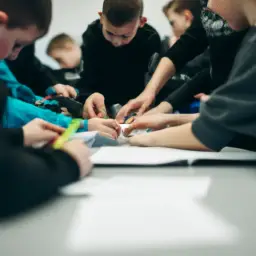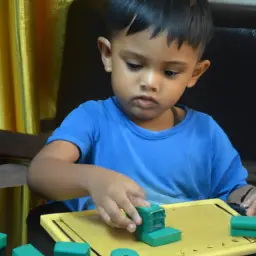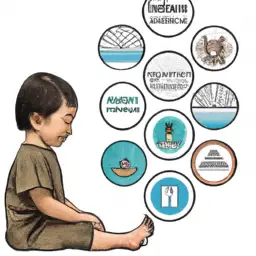As a teacher, you know that developing grit in your students is crucial for their success in school and beyond. Grit, defined as perseverance and passion for long-term goals, has been linked to academic achievement, career success, and overall well-being.
But did you know that parental involvement can play a significant role in the development of grit in children?
Research has shown that parents who are involved in their children’s education and provide support and encouragement can help foster the development of grit. As a teacher, you have the opportunity to promote parental involvement and provide strategies to help parents support their children’s grit development.
In this article, we will explore the relationship between parental involvement and grit development, examine studies on the impact of parental involvement on grit, and provide insights and strategies for teachers to promote parental involvement and grit development in the classroom.
Key Takeaways
- Parental involvement plays a significant role in developing grit in children.
- Teachers can promote parental involvement and provide strategies to support grit development.
- Creating a supportive classroom atmosphere can help develop grit.
- Involving parents in their child’s education can promote grit development.
Definition and Importance of Grit
You can’t underestimate the importance of grit – it’s what keeps you going when things get tough. Grit is the ability to persevere through challenges, setbacks, and failures, without giving up or losing sight of your goals. It’s a combination of persistence, resilience, determination, and passion, all rolled into one.
Gritty individuals are able to push through difficult times, learn from their mistakes, and emerge stronger and more resilient on the other side. The characteristics of grit are many, but some of the most important include a growth mindset, a positive attitude, a willingness to take risks, and a strong sense of purpose.
A gritty individual is someone who believes that their abilities can be developed through hard work and dedication, rather than being fixed at birth. They see failure as an opportunity to learn and grow, rather than a reflection of their worth or ability. They are also willing to take risks and step outside of their comfort zone in pursuit of their goals, and they have a clear sense of purpose that guides them through tough times.
All of these traits are important for success in life, and they can be developed and nurtured through parental involvement and support.
The Relationship Between Parental Involvement and Grit Development
When it comes to developing grit in your children, the importance of a supportive environment can’t be overstated. By providing encouragement and reinforcement, you can help foster persistence through challenges and setbacks.
Additionally, modeling grit yourself can inspire your children to develop their own resilience and perseverance in the face of adversity.
Supportive Environment for Persistence Through Challenges
Creating a supportive classroom atmosphere can help you develop grit and persist through challenges. As a teacher, you play a crucial role in creating a motivating atmosphere that encourages a growth mindset. Here are some ways you can create a supportive environment for persistence through challenges:
-
Encourage risk-taking: Encourage your students to take risks and try new things. Let them know that it’s okay to make mistakes and that failure is a natural part of the learning process. This will help them develop a growth mindset and become more resilient in the face of challenges.
-
Provide feedback: Provide your students with constructive feedback that helps them improve their skills and knowledge. This will help them see the value in persistence and hard work, and encourage them to keep trying even when things get tough.
-
Celebrate success: Celebrate your students’ successes, no matter how small. This will help them build confidence and feel motivated to keep working hard. It will also help them see that persistence pays off in the end.
By creating a supportive classroom atmosphere that encourages persistence and a growth mindset, you can help your students develop grit and succeed in the face of challenges.
Modeling Grit to Inspire Children
Get inspired by seeing how others demonstrate grit and perseverance, and let that motivate you to model it for children. Role modeling is one of the most effective ways to teach children the value of resilience and determination.
When children see adults taking on challenges and persisting even when things get tough, they’re more likely to internalize those values and develop their own resilience. As a teacher, you can be that role model for your students.
Share stories of your own challenges and how you overcame them. Show them that it’s okay to fail, as long as you keep trying. Encourage them to take risks and embrace challenges, and cheer them on when they do.
Inspiring resilience in children is not just about teaching them the value of grit, but also about creating a supportive environment where they feel safe to take risks and make mistakes.
As a teacher, you can create that environment by providing opportunities for children to practice resilience, such as challenging assignments or group projects that require teamwork and perseverance. Celebrate their successes and help them learn from their failures. Encourage them to support each other and work together to overcome obstacles.
By modeling grit and creating a supportive environment, you can help your students develop the resilience they need to succeed in school and in life.
Studies on the Impact of Parental Involvement on Grit Development
Parents’ involvement in their children’s lives can have a powerful impact on the development of grit, as research has shown.
Studies have found that when parents actively engage with their children, encourage their interests, and provide them with support and guidance, children are more likely to develop grit.
This is because parental involvement can provide children with a sense of security, as well as a foundation of values and beliefs that can help them persevere through challenges.
Moreover, the long-term effects of parental involvement on grit development are significant. Children who have parents that are involved in their lives are more likely to have higher levels of grit, which can lead to greater success in school and in life.
However, it is important to note that cultural differences can impact the way in which parents approach involvement in their children’s lives. Therefore, it’s crucial for teachers to be aware of cultural differences and to work with parents to find ways to support their children’s development of grit.
Insights for Teachers to Promote Parental Involvement
As a teacher, you can foster a strong partnership with families by regularly communicating with them and involving them in their child’s education. Parent-teacher collaboration is crucial in promoting parental involvement, which in turn, has a positive impact on a child’s grit development. Effective communication is the key to building this partnership. Make sure to communicate with parents about their child’s progress, both academically and socially. This can be done through parent-teacher conferences, progress reports, and informal check-ins.
In addition, involving parents in their child’s education can also promote grit development. Provide opportunities for parents to volunteer in the classroom or participate in school events. This not only gives parents a chance to see their child in action but also helps them feel more connected to the school community. By working together, teachers and parents can create a supportive environment that fosters grit development in children. Remember, building a strong partnership with families takes effort, but the benefits for the child are immeasurable.
| Parent-Teacher Collaboration | Effective Communication | Benefits for Children |
|---|---|---|
| 1. Regular communication with parents | 1. Communicate about child’s progress | 1. Positive impact on grit development |
| 2. Parent-teacher conferences | 2. Provide progress reports | 2. Opportunities for parental involvement |
| 3. Informal check-ins | 3. Encourage parent volunteering | 3. Increased connection to school community |
| 4. Involve parents in school events | 4. Work together to create supportive environment | 4. Improved academic and social progress |
| 5. Build strong partnership with families | 5. Effort required, but benefits are immeasurable | 5. Increased motivation and perseverance |
Strategies for Teachers to Promote Grit Development in the Classroom
To promote grit development in your classroom, you can encourage persistence through challenges by providing opportunities for students to tackle difficult tasks and helping them break down the steps needed to complete them.
Another strategy is setting long-term goals with your students, such as creating a class project that will take several weeks or months to complete, and regularly checking in on progress towards that goal.
Finally, celebrate successes with your students, no matter how small, to reinforce the importance of perseverance and hard work.
Encouraging Persistence Through Challenges
You can help your students develop grit by encouraging them to persist through challenges, even when things get tough. Here are some effective strategies that you can use in your classroom to promote persistence:
-
Provide opportunities for failure: Encourage your students to take risks and try new things, even if they might fail. When they do fail, help them see it as a learning opportunity rather than a setback. This will help them build resilience and develop a growth mindset.
-
Celebrate progress: Instead of focusing solely on the end result, celebrate the progress your students make along the way. This will help them see that even small steps forward are worth celebrating and can motivate them to keep going. You can do this by setting small goals and acknowledging when they’re met, or by highlighting specific improvements in their work.
By implementing these practical strategies, you can help your students develop the perseverance they need to succeed in school and beyond. Remember, grit isn’t just about talent or intelligence, but about the willingness to work hard and persist through challenges.
Setting Long-Term Goals
If you want to achieve long-term success, it’s important to set specific goals that align with your values and aspirations. Setting long-term goals can help you stay focused and motivated, even when faced with challenges or setbacks. The importance of visualization cannot be overstated when it comes to goal setting. When you visualize your desired outcome, you create a mental image that can help you stay motivated and focused on what you want to achieve.
To set effective long-term goals, there are several strategies you can use. First, make sure your goals are specific, measurable, achievable, relevant, and time-bound (SMART). This will help you break down your larger goal into smaller, more manageable steps. Next, create a plan to achieve your goal by identifying the resources, skills, and support you need to succeed. Finally, track your progress and adjust your plan as needed. By following these strategies, you can achieve your long-term goals and develop the grit needed to persevere through challenges.
| Positive Emotions | Negative Emotions |
|---|---|
| Joy | Fear |
| Gratitude | Frustration |
| Excitement | Anxiety |
This table can help you identify the emotions associated with goal setting. By focusing on positive emotions and finding ways to manage negative emotions, you can increase your chances of achieving your long-term goals. Remember, setting long-term goals takes time and effort, but with the right strategies and mindset, you can develop the grit needed to overcome any obstacle.
Celebrating Successes
Celebrating our successes is essential for maintaining motivation and building confidence in our abilities. The importance of recognition can’t be stressed enough, especially when it comes to developing grit.
By acknowledging and celebrating the small victories, we’re able to see our progress and feel a sense of accomplishment. This fuels our motivation to continue working towards our long-term goals.
In addition to recognition, cultivating a growth mindset is also crucial for developing grit. This means embracing challenges and seeing failures as opportunities for growth.
When we celebrate our successes, we also reinforce the idea that hard work and perseverance pay off. This mindset shift helps us view challenges as opportunities to learn and improve, rather than as obstacles to be avoided.
As teachers, it’s important to provide opportunities for students to celebrate their successes and cultivate a growth mindset in the classroom.
Conclusion
Congratulations! You’ve learned about the importance of grit and how parental involvement can impact its development.
Research has shown that parents who are involved in their children’s education and encourage a growth mindset can foster grit in their children.
As a teacher, you can promote parental involvement by offering parent-teacher conferences, sending home regular progress reports, and creating opportunities for parents to volunteer in the classroom.
In addition to promoting parental involvement, there are also strategies you can implement in the classroom to promote grit development. These include providing challenging tasks, emphasizing effort over natural ability, and teaching students to set and work towards long-term goals.
By promoting grit development in your students and encouraging parental involvement, you can help set your students on a path towards success both in and out of the classroom. Keep up the great work!





































































































